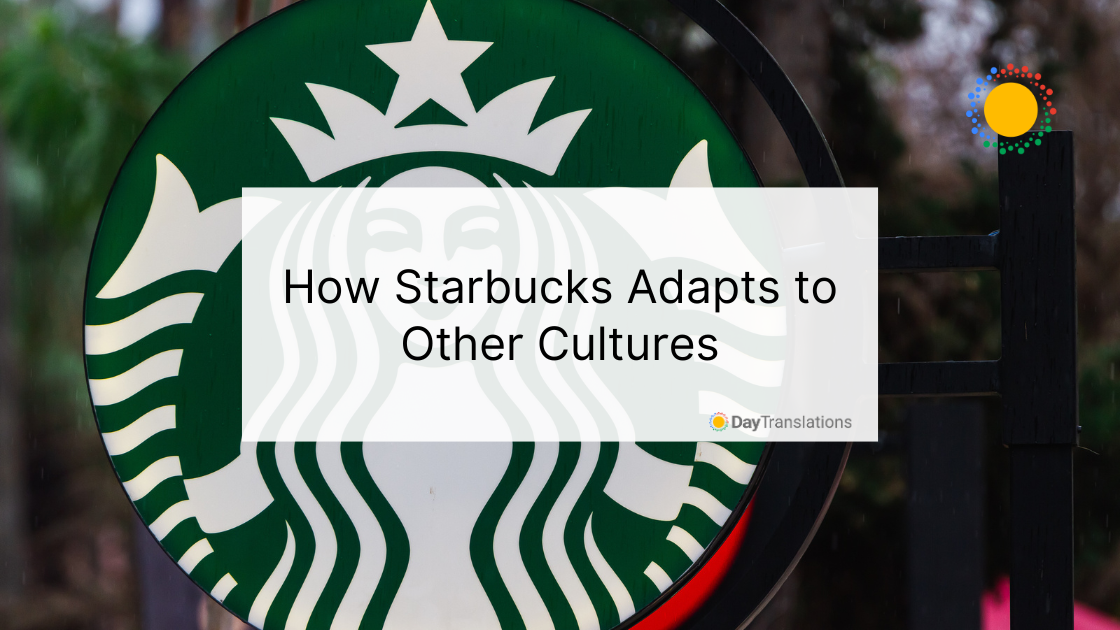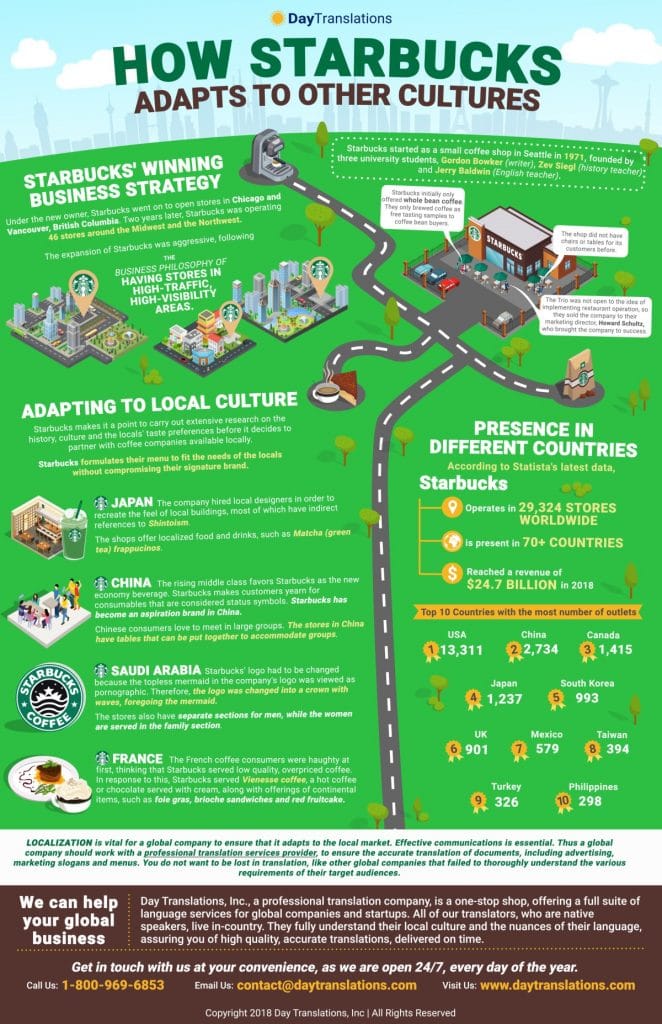For coffee lovers, it is highly probable that you got your caffeine fix from a Starbucks store near you. Heck, you don’t even have to que since you can pre-order on their mobile app! Just like other American fast food chains,
Starbucks is almost everywhere. During the early morning rush, just before people enter their offices, it’s a typical scenario to see a throng of people lined up in a Starbucks shop, waiting for be served. It’s amazing how what used to be a simple cup of brewed coffee can change the tastes of people from different cultures.
In this post, we’ll be looking at how the brand caters to different cultures around the world!
How it all started
Starbucks started as a small coffee shop in Seattle in 1971, founded by three university students. However, what they did with their coffee shop changed the way people look at coffee. The three entrepreneurs were Gordon Bowker (writer), Zev Siegl (history teacher) and Jerry Baldwin (English teacher).
They were inspired by the owner of the Peet’s Coffee and Tea, which was near the University of San Francisco. The owner, Alfred Peet, taught the trio how to blend, roast and cup brewed coffee. He also shared with them his inflexible standards. And as a result, the brilliance of Starbucks was bred.
Did you know that when they had to name their coffee bean company they chose the name of the chief mate in Moby Dick?
Their first coffee shop operated at Seattle’s 2000 Western Avenue. They moved to a location at 1912 Pikes Place after five years. Starbucks initially only offered whole bean coffee. They only brewed coffee as free tasting samples to coffee bean buyers. The shop did not have chairs or tables for its customers.
Trip to Milan and some changes
Howard Schultz, the new marketing director of Starbucks went to Milan on a buying trip in 1982. He saw several coffee bars situated in almost every street in the city. The cafés served very good espresso. But the shops were also meeting places, especially in the mornings, as Italians love their morning coffee.
Upon his return to the United States, Schultz tried to convince the owners to open coffee shops because he believed that it was the way for Starbucks to be more profitable and successful. They opened a pilot shop in 1984, but the owners were not open to the idea of implementing the concept across the company because they refused to go into restaurant operation.
Schultz resigned from Starbucks and opened his own concept coffee shop. He named it Il Giornale, which served espresso Italian style and ice cream. Customers were treated to the sound of Italian opera when they are at the shop. In 1987, the original Starbucks owners offered to sell the company, and Schultz immediately grabbed the opportunity.
New owners, new directions
Under the new owner, Starbucks went on to open stores in Chicago and Vancouver, British Columbia. Two years later, under Schultz, Starbucks was operating 46 stores around the Midwest and the Northwest.
The expansion of Starbucks was aggressive, following the business philosophy of having stores in high-traffic, high-visibility areas. When the company established its IPO in mid-1992, it was already operating 140 shops. With the IPO, the company was able to double the number of its stores. To reach even more audience members, they offer quick and convenient mobile app ordering options too!
Starbucks‘ winning business strategy
The aggressiveness of the brand to gain new Starbucks locations continues to this day. It is now present in over 70 countries worldwide. Its biggest areas of operation outside of the United States are China, Canada, Japan and South Korea. It’s such a popular brand that thousands of people even have their own Starbucks reward visa card!
The success and acceptance of Starbucks by different cultures stems from its carefully planned business strategy – localization. With localization, Starbucks is able to adapt to the tastes of different cultures, managing to convince consumers in other locations to drink coffee. This is particularly impressive in Asia where tea is the preferred drink.
Localization, one of many translation services, goes beyond standard translation. The service ensures that all information about a company and product is in the local language. In some cases, it requires some changes in the brand’s colors and appearance as well as adapting the brand name to fit the local culture.
Company websites are localized, making them available in the local language and conforming to local preferences, traditions, beliefs, laws and regulations. Localization makes the company approachable and accessible, eliciting trust and confidence from local consumers because the company becomes one with them, a company that understands and responds to their needs.
Adapting to local culture
Starbucks makes it a point to carry out extensive research on the history, culture and the locals’ taste preferences before it decides to partner with coffee companies and participating stores available locally.
Their market research is done before they start to build their participating stores in the target location. Starbucks formulates their menu to fit the needs of the locals without compromising their signature brand.
Its localization strategy is a mix of local products with innovative store designs, so they are able to fully adapt to the culture of the location. Here are some examples.
Starbucks maintains 18 design centers worldwide, which work to understand and conceptualize store designs to reflect the local market.
Japan
In Japan, local buildings have low roofs and most of them have indirect references to Shintoism, which is the country’s religion. The company hired local designers in order to create the right atmosphere in participating stores.
For example, the store in Fukuoka used 2,000 wood blocks that interlock to give a forest-like feel to the place and honor nature, in reference to the religion. The store in Meguro looks like a local craft store, with the style of a traditional Japanese teahouse.
The shops offer localized food and drinks, such as the matcha (green tea) frappucinos. The servings are smaller and less sweet than the items sold in American stores.
China
The rising middle class in China favors Starbucks, which has made the consumers yearn for consumables that are considered status symbols. Starbucks became an aspiration brand in participating stores in China. The company also used innovative designs for their stores in China, hiring Kengo Kuma, a well-known Japanese architect.
Because Chinese consumers love to meet in large groups, the stores in China have tables that can be put together to accommodate groups. But before they started selling coffee, Starbucks first started serving tea, allowing the consumers to enjoy the different environment, working on the ”aspiration” feel. Once the Chinese market became comfortable with the brand, they started offering their signature products.
Saudi Arabia
In Saudi Arabia, the logo of Starbucks in participating stores and overall branding had to be changed because the topless mermaid in the company’s logo was viewed as pornographic. Therefore, the logo was changed into a crown with waves, foregoing the mermaid. In fact, if you want to recreate the Starbucks logo, using an AI logo maker helps speed up the process. The stores also have separate sections for men, while the women are served in the family section.
France
The French coffee consumers were haughty at first, thinking that Starbucks served coffee of low quality that was overpriced. In response to this, Starbucks served Vienesse coffee, a hot coffee or chocolate served with cream), along with offerings of continental items in participating stores, such as foie gras and brioche sandwiches and red fruitcake.
These are just some of the many innovative ideas Starbucks used to create market superiority in all the locations they are in around the world.
Global locations of Starbucks
According to Statista’s latest data, Starbucks operates 29,324 stores worldwide as of 2018. While some are operated by franchisees, the rest are owned and operated by the company. It is present in 73 countries.
- United States (13,311)
- China (2,734)
- Canada (1,415)
- Japan (1,237)
- South Korea (993)
- United Kingdom (901)
- Mexico (579)
- Taiwan (394)
- Turkey (326)
- Philippines (298)
- Thailand (289)
- Indonesian (268)
- Malaysia (234)
- Germany (160)
- United Arab Emirates (144)
- France (132)
- Singapore (130)
- Russia (109)
- Argentina (108)
- Kuwait (106)
- Saudi Arabia (102)
- Brazil (102)
- Spain (101)
- Chile (96)
- Peru (89)
- India (88)
- Ireland (73)
- Switzerland (61)
- Netherlands (59)
- Poland (53)
- Egypt (31)
- Lebanon (29)
- Greece (28)
- Czech Republic (28)
- Romania (27)
- Vietnam (25)
- New Zealand (24)
- Puerto Rico (23)
- Australia (22)
- Denmark (21)
- Bahrain (21)
- Belgium (19)
- Sweden (18)
- Qatar (18)
- Austria (18)
- Norway (17)
- Jordan (17)
- Hungary (16)
- Oman (12)
- Portugal (11)
- El Salvador (11)
- Costa Rica (11)
- Colombia (11)
- Cyprus (10)
- Bahamas (10)
- Morocco (9)
- Kazakhstan (8)
- Finland (8)
- Guatemala (7)
- Panama (5)
- Bulgaria (5)
- Brunei (5)
- Cambodia (4)
- Bolivia (4)
- Azerbaijan (4)
- Trinidad and Tobago (3)
- South Africa (3)
- Slovakia (3)
- Curaçao (3)
- Aruba (3)
- Monaco (2)
- Luxembourg (2)
- Andorra (1)
Translation and localization for business adaptation
We at Day Translations, Inc. understand how critical proper communication is, particularly for a global business. Aside from communication, a company has to adapt to the local culture to ensure success. Translation and localization, services that we offer, are essential for companies operating in different countries.
They allow companies to fully adapt to local culture by having information and content available in a specific territory’s main language. It helps local customers identify with the company, gaining their trust and their patronage.
Collaborate with Day Translations for all your corporate translation and localization requirements. Our human translators, who are located around the globe, are all native speakers and subject matter experts. They are ready to work on different industry sectors, and share their knowledge, experience and linguistic and creative writing skills with you.
You can get in touch with us anytime, as we are open 24/7, every day of the year. Tell us what you need by calling us at 1-800-969-6853 or sending us an email here: Contact us.
Share this Infographic On Your Site
Image Copyright: Teerawut Masawat / 123RF Stock Photo















Sorry, the comment form is closed at this time.